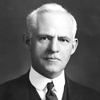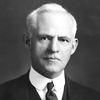Reinvention, 1961–1973
A Return to Proactive Problem-Solving
Believing the resources of the Cleveland Foundation were being underutilized in combating the city’s postwar stagnation, one of the community’s most prominent business and civic leaders, Harold T. Clark, a one-time foundation board member, spearheaded the creation of a new philanthropy to set an example of research and experimentation that he hoped the older foundation would emulate. Established in late 1961, the Greater Cleveland Associated Foundation (GCAF) was collaboratively funded by the Leonard C. Hanna Jr. Fund, the largest private foundation in Cleveland, over whose board Clark presided, and the Ford Foundation in New York, which was testing a variety of responses to growing national uneasiness about the future of American cities. GCAF operated under the Cleveland Foundation’s loose auspices for only six years, but it ultimately exerted a profound influence on the older philanthropy, prompting its re-emergence as a catalyst for significant improvement in the quality of life of Cleveland’s 1.6 million residents.

The Cleveland Foundation emerged from the crucible of the 1960s a stronger leader and more strategic grantmaker.
 Carl B. Stokes at a town hall meeting, 1969: an historic but troubled mayoral administration
Carl B. Stokes at a town hall meeting, 1969: an historic but troubled mayoral administration  An assembly line at the Ford Motor Company plant in Brook Park, 1973: manufacturing jobs on the decline
An assembly line at the Ford Motor Company plant in Brook Park, 1973: manufacturing jobs on the decline Contaminants flowing into Lake Erie, 1965
Contaminants flowing into Lake Erie, 1965 Clean water advocates, 1968
Clean water advocates, 1968 An east-side Cleveland elementary school, 1963: growing frustration with what appears to be systematic segregation
An east-side Cleveland elementary school, 1963: growing frustration with what appears to be systematic segregation Protest demonstration at Cleveland State University, 1969: poverty rates in the central city on the rise
Protest demonstration at Cleveland State University, 1969: poverty rates in the central city on the rise The NAACP-Cleveland’s fight for desegregation ultimately leads in 1973 to a federal lawsuit against the Cleveland public schools: the likelihood of court-ordering busing
The NAACP-Cleveland’s fight for desegregation ultimately leads in 1973 to a federal lawsuit against the Cleveland public schools: the likelihood of court-ordering busing Shrewdly, Clark never made plain his reformative intentions for the Cleveland Foundation’s $41 million endowment in discussions that led to the foundation’s agreement to act as fiscal agent for the Hanna and Ford grants. Instead, he cloaked his plans in solicitousness for Cleveland’s entire nonprofit community. (Learn more about Clark’s rationale for this undertaking.) At a luncheon to announce GCAF’s creation on December 18, 1961, hosted by the foundation for more than 200 probate lawyers, trust officers of banks and trustees of other local foundations, Ellwood H. Fisher, the chairman of the foundation’s board, explained that GCAF would dedicate itself to exploring “possible solutions to broad problems that are too extensive and too costly to be attacked by existing organizations, which must concentrate on solving today’s urgent problems today.”
Although legally a nonprofit Ohio corporation with its own staff and 11-member board, GCAF was technically a new trust fund of the Cleveland Foundation. “All of its funds will go for studying community needs, proposing solutions to problems and making these findings available to philanthropic, service and government organizations,” Fisher noted. “The foundation [GCAF] is also expected to finance pilot and demonstration projects when these may point the way to new community ventures.” GCAF planned to expend both the income and principal of the Ford and Hanna grants, each totaling $1.25 million, in five years, at which time the grantors would consider renewing their awards.
It is difficult to overstate the influence that GCAF, under the leadership of director James A. Norton and chairman Kent H. Smith, wielded in Cleveland during the tumultuous 1960s. In the years preceding the election of Carl B. Stokes as Cleveland’s mayor in 1967, GCAF sparked or shaped public debate on the need for improvements in the schools, race relations and city governance, thus helping to create a climate for reform. Acting on the new ideas generated, GCAF helped make possible such sweeping changes as the creation of the first publicly supported community college in the state, the integration of Cleveland’s near eastern suburbs and the overhaul of the management structure of Cleveland City Hall.
After Stokes’s historic election as the first African-American mayor of a major American city, GCAF (which had by then combined forces with the Cleveland Foundation) worked hand-in-glove with the new mayor to ensure the success of his programs. Setting a national philanthropic precedent by directing funding to local government, GCAF provided the Stokes administration with unbudgeted personnel and additional resources needed to rebuild Cleveland after the physical and emotional destruction wreaked by the Hough riots in 1966.
The Ford Foundation awarded a second and final grant of $1.25 million to GCAF at the end of its first five years of operation. Conceiving a plan to ensure the continuation of GCAF’s groundbreaking work as a risk taker, catalyst and bridge builder, Norton and Smith approached John Sherwin Sr., who had succeeded Ellwood Fisher as the Cleveland Foundation’s chairman, with a suggestion that the two philanthropies merge. They found an immediate ally in Sherwin, who had become troubled by the unimaginative nature of most of the grants presented to the board for approval. As he would later bluntly put it: “I got tired of [receiving] applications to buy a new station wagon for some institution. I always felt that [we were] not there to … just support existing budgets…. I felt it was our job to start things … to look into matters of civic interest.”
Sherwin marshaled the support of his board colleagues, who, on April 14, 1967, paved the way for the ultimate merger of the two foundations by creating an identical, 11-member board chaired by Sherwin to govern each foundation, which temporarily remained separate entities. (GCAF was renamed Cleveland Foundation Inc. and kept intact because it had certain powers, such as the ability to issue checks, which the older foundation lacked because it was not legally a corporation.) Upon the retirement of J. Kimball Johnson at the end of 1967, Norton became the fifth director of the Cleveland Foundation. Serving in that capacity until 1973, Norton refocused the foundation’s attention on undertaking GCAF-style initiatives such as sweeping reform of the county’s criminal justice system. In the opinion of Norton’s successor, Homer Wadsworth, GCAF’s lasting contribution was in redirecting the Cleveland Foundation’s significant resources—the endowment stood at nearly $120 million in 1967—to support fresh approaches to the solution of urban problems.

